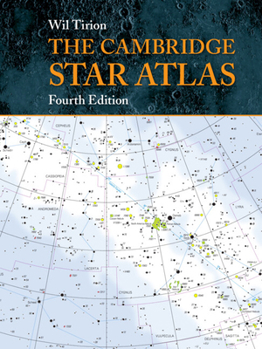The Cambridge Star Atlas
Select Format
Select Condition 
Book Overview
This classic star atlas is ideal for both beginning astronomers and more experienced observers worldwide. The clear, full-color maps show stars, clusters and galaxies visible with binoculars or a small telescope. The atlas also features constellation boundaries and the Milky Way, and lists objects that are interesting to observe. This new edition features a clearer map of the Moon's surface, showing craters and features; a second Moon map, mirror reversed for users of telescopes with star diagonals; enhanced index charts showing the constellations more clearly; and a new data table listing stars hosting planetary systems. It is now spiral bound, making it ideal for use at the telescope.
Format:Spiral-bound
Language:English
ISBN:B009CUNLUA
ISBN13:9780521173636
Release Date:January 2011
Publisher:Cambridge University Press
Length:95 Pages
Weight:0.04 lbs.
Dimensions:0.3" x 9.2" x 11.9"
Customer Reviews
5 ratings
Observer's companion
Published by Thriftbooks.com User , 17 years ago
This star atlas is both aesthetically pleasing and useful. The large pages made it possible to read the charts without having to resort to a magnifying glass. Coupled with a red flashight of some sort (e.g. Gerber ReconGerber 22-80016 Recon Light, White / Red / Blue / Green LED - Black Body it's a nice companion for observing.
Best wide field star atlas
Published by Thriftbooks.com User , 23 years ago
Having looked at all the alternatives, this is my favorite small star atlas. With each chart covering 4 hours of right ascension, this atlas lets you get oriented to the major features of a part of the sky in order to start a star-hop. It includes plenty of deep-sky objects to keep you busy.It is *not* sufficient to show all the stars or objects you can see in a small scope - for that, you need Uranometria 2000 (also by Trion) or the Millenium Sky Atlas. But then you're talking a major investmant. In the field, I tend to use Cambridge and Uranometria - Cambridge for star-hopping in close, then Uranometria for nailing down the exact field.By now, my copy is somewhat warped from absorbing so much dew over so many nights - but it still lies flat when opened. As others have mentioned, the monthly charts are somewhat superfluous if you have a planisphere. Anyhow, as you learn the sky, a planisphere quickly becomes unnecessary.
Your companion to the Stars.
Published by Thriftbooks.com User , 25 years ago
Computers too bulky, pocket books too small? This is probably one of the better books to have at your observing session and site. It makes your observing just that much easier. The pages are loaded with information that others lack. Granted the book does not include all the stars, and why would you want too? It would only add to the confusion of finding the object your really after when your out there in the dark looking at the pages under a red light! The book limits itself to the 23rd magnitude which is fine! Anything beyond that is over kill for the amatuer astronomer anyway. This book gives you the meat and potato's! Good stuff!
Excellent beginning to intermediate amateur astronomer guide
Published by Thriftbooks.com User , 26 years ago
It's a star atlas and planisphere all in one convenient guide. Plenty of deep sky objects are included with an excellent display of object distribution in the Milky Way. A must have resource for amateur astronomers.
The perfect size
Published by Thriftbooks.com User , 27 years ago
In addition to this atlas, I own Sky Atlas 2000, Uranometria, and the Millenium Star Atlas, and this is by far the one I use the most. It is a scaled down version of Sky Atlas 2000, and it's reduced size, the convienience of having more of the sky fit on each map, and the increased overlap between charts far outweigh the extra detail you get with Sky Atlas. Of course there are times when more detail is needed, but at these times it's usually best to go stright to Uranometria or MSA. There are a few annoying printing errors, but not enough to interfere with the practicality of the atlas. There are enough deep sky objects plotted to keep you busy for a long time.






